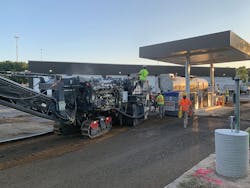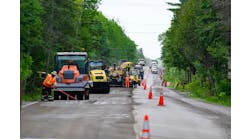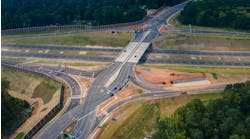Motorists traversing Route 90 in New Jersey on their way to Pennsylvania over the Delaware River would cross the nearly 45-year-old Betsy Ross Bridge to make the journey.
The continuous steel truss bridge connects Pennsauken, New Jersey to Philadelphia on the other side of the river. According to the Delaware River Port Authority (DRPA), 13.1 million vehicles crossed the six-lane bridge from both directions in 2019.
In 2020, the DRPA advanced a construction contract for the rehabilitation of the pavement on the New Jersey approaches to the Betsy Ross Bridge. The overall project included work on all ramps within the DRPA’s jurisdiction, mainline Route 90, and all parking lots and service roads of the Administration and Maintenance Building Complex.
“DRPA’s assessment of the pavement condition saw the pavement in the general area of the New Jersey approaches of the Betsy Ross Bridge were in need of a rehabilitation,” Greg Bitsko, New Jersey Regional Structures Leader for Traffic Planning and Design Inc., told Roads & Bridges. “And in particular, it was the service roads and the parking lots at the Betsy Ross Bridge administration building. It was exhibiting normal aged pavement conditions: cracking, settlement, general wear and tear; the pavement was old in the parking lots. And there were increasing maintenance needs.”
When it came to the work on the service roads and parking lots, DRPA completed this aspect of the project using a combination of pavement recycling and modified conventional construction techniques that incorporated stockpiled, excess recycled material. Traffic Planning and Design Inc. served as the project designer, South State Inc. was the prime contractor, and Advanced Paving Systems played a role as recycling subcontractor.
PAVING ALTERNATIVES
Preliminary field investigations led the team to decide to fully reconstruct the parking lots and service roads at the Administration and Maintenance Building Complex.
The four parking areas included an Upper Lot (200 ft x 200 ft); Middle Lot (150 ft x 60 ft); Lower Maintenance Lot (500 ft x 120 ft on average); and a Salt Storage Lot (240 ft x 140 ft). The first service road (Access Road A) was 28 ft wide and 1,415 ft long, while the second service road (Access Road B) was 26 ft wide and 2,450 ft long.
The tricky part of this work was that the team needed to ensure 24/7 unrestricted access to the facilities—including the garages, storage areas, and fueling station—for DRPA personnel. On top of that, the service roads were in constant use by construction vehicles traveling to and from other work zones along Route 90.
Conventional construction was not considered due to limited work-zone availability from access constraints and because of the additional construction traffic these operations would add to an already congested site. Therefore, the DRPA considered the use of pavement recycling alternatives.
“The service roads are heavily used, and our initial thought was conventional construction—although feasible—was just not going to be as effective as a recycling option to avoid impacts to the DRPA’s maintenance personnel,” Bitsko said. “The other aspect is these facilities, these service roads, were going to be in use during the repaving of the mainline. So therefore you really couldn’t take these out of service for a long period of time because the other vehicles were accessing on and off site through these service roads.”
The DRPA previously used full-depth cement-based pavement recycling for another parking lot project. While the results were satisfactory for that project, DRPA said the work areas had to remain off limits to traffic for up to seven days while the material cured. This closure period was not feasible at the Betsy Ross Bridge facilities. After evaluating other recycling options, the DRPA approved the use of foamed asphalt recycling (FAR), which has traditionally permitted a very short return to service time.
A BENEFICIAL PROJECT
The service roads were recycled one lane at a time in a continuous operation to the greatest extent possible. Access in the adjacent lane was not restricted. Rolling commenced immediately after the material was placed. When the service roads were recycled across the driveways to the maintenance yard, DRPA vehicles would immediately cross the material with no adverse effects.
The most unique aspect of the project was the stockpiling and reuse of excess recycled material. The existing pavement was 5 in. thick and was recycled in its entirety, but only a 3-in. base course was constructed. The other 2 in. of material would normally be disposed of, but the project afforded an opportunity to use 100% of the material.
Shoulders on Access Road A were pre-milled with a smaller Wirtgen machine. The material was placed in a furrow for subsequent recycling passes. Throughout the project, the paving train included a cement spreader from Diversified Fabricators Inc., an asphalt tanker semi-trailer pushed by a Wirtgen 3800 CR recycler, discharging into a Cat AP665D paver with initial compaction by a Cat CB534D Steel Vibratory Roller, and finished with a Cat PS560C rubber tire roller.
One of the three parking lots could not be recycled in place due to internal islands and overall geometry. Additionally, the cutting head of the recycler is 75 ft from the rear of the train and recycling could not occur within this distance of some buildings in the other lots. The areas not recycled were excavated conventionally, but all base was constructed with the stockpiled recycled material, reducing reliance on traditional hot mix asphalt (HMA). The stockpiled material was stored on site, loaded into dump trucks, and placed with conventional pavers when needed.
“We have three big benefits on the project-—better environmentally because instead of shipping in DGA [dense graded aggregate] down to the site and hauling that old milled material, we were able to use the stockpiles on site, so there were less trucks coming in and out, which was great,” Steven DeVillasanta, Senior Engineer at DRPA, told Roads & Bridges. “Plus, the speed we were able to drive trucks over almost immediately after use, and then also the financial savings of doing this versus traditional full-depth reconstruction.”
According to Bitsko, the concept of stockpiling and reusing FAR material had been discussed theoretically with Wirtgen representatives in the past, but this was one of the first opportunities to put the theory into practice. Because of the characteristics of FAR, it was believed to be possible to stockpile the material and reuse it later if the piles are limited in height (approximately 4-5 ft) to restrict overburden weight which would result in self-compaction. One challenge for the project team was to monitor the stockpiles during construction to verify their height was not adversely affecting the material. Ultimately, stockpile heights not exceeding 5 ft were used with no adverse effects. The contractor, Advanced Paving Systems, had never used this method before and is not aware of anyone who has.
DEMONSTRATING EFFECTIVE MATERIAL
For the team behind the Betsy Ross Bridge New Jersey Approach Pavement Rehabilitation project, the work on the service roads and parking lots fully demonstrated the flexibility and usefulness of FAR, showing that traffic can be returned to normal within minutes of rolling the material. This helped earn the project a Roads & Bridges / ARRA Recycling Award for 2021.
“It must be remembered that this is effectively full-depth pavement reconstruction accomplished within minutes and reopened almost immediately, instead of hours or days for other processes,” Bitsko said. “The results of this project should encourage engineers that FAR is an extremely viable option to ‘get out’ as quickly as possible without adverse effects.”
The recycling costs on this project were only 13% below conventional construction, which is much less of a difference than is typically expected. However, the bid specifications for this project did not provide for continuous operations due to parking lot access constraints.
Work on the service roads and parking lots began May 26, 2020 and finished up on June 15, 2020. The DRPA says it is pleased with the results of this project, and the agency is looking for other opportunities to use FAR.






